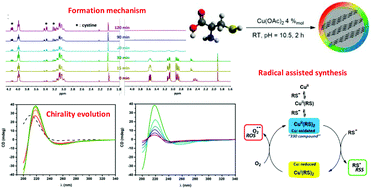The formation mechanism and chirality evolution of chiral carbon dots prepared via radical assisted synthesis at room temperature†
Abstract
We report on a Cu(II) catalyzed process for the production of cysteine based chiral carbon dots; the process does not require any thermal treatment and the carbon dot formation is driven by the production of reactive radical species that are generated in the reaction media by the catalytic role played by the multivalent transition metal. The nanomaterial presents a well-defined chirality and the enantioselectivity of the synthesis is proved by the isolation of both the carbon dot enantiomers. We focused our attention on the processes that take place during the carbon dot formation and the relationship with the structure of the organic starting material. Thanks to the comparison of reactions conducted with different organic substrates whose thiyl radical chemistry is known, we recognized a non-trivial role of the radical hydrogen abstraction reactions in the carbon dot formation process. The reported process allows access to a large variety of analyses to monitor the reaction mixtures during the reaction course. Finally, we report a detailed analysis on the evolution of optical chirality during the synthesis and related this feature with the formation mechanism of the nanomaterial revealing significant evidence on the chirality origin and structure of chiral carbon dots.

- This article is part of the themed collection: Nanoscale and Nanoscale Horizons: Carbon-based nanomaterials


 Please wait while we load your content...
Please wait while we load your content...